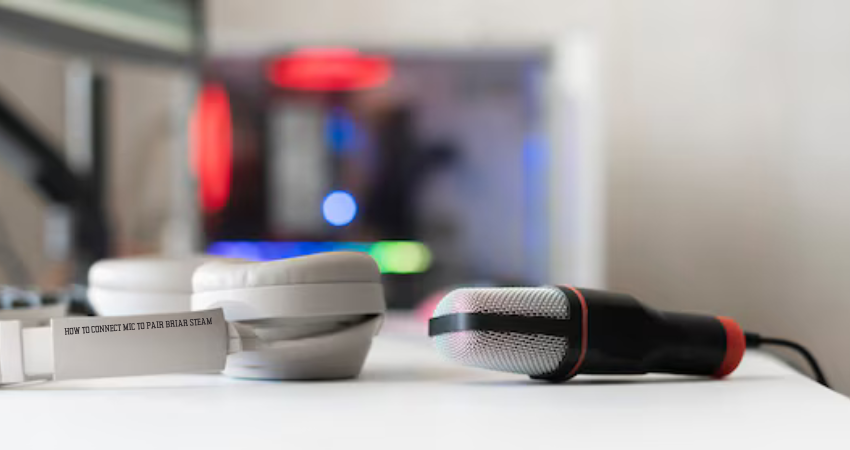The story of how to connect mic to pair briar steam may seem to be a mere technical process in modern times, but it is a tale that intertwines ingenuity, perseverance, and the unyielding desire for communication. Through this narrative, we journey across decades of human innovation, tracing the origins of microphones, the evolution of audio connectivity, and the emergence of platforms like Briar Steam that encapsulate the essence of collaboration and expression.
This is not just a guide; it’s a reflection on how humanity’s voice found its way through the ether, how whispers became waves, and how waves shaped connections in ways we had only dreamed.
The Origins of the Microphone: Giving Voice to the Voiceless
How to connect mic to pair briar steam story begins in the 19th century, a time when voices were bound by proximity and limited to the physical presence of the speaker. With the advent of telephony in the 1870s, Alexander Graham Bell, Elisha Gray, and Thomas Edison were among the minds that laid the groundwork for sound transmission. Yet it was Emile Berliner, in 1876, who brought forth the first true microphone. His carbon-button transmitter was a breakthrough, capturing the nuance of human speech and making it audible across distances.
In these early days, connecting a microphone was less about plugging in a cable and more about aligning copper wires and chemical reactions. The world was on the precipice of something revolutionary—voices no longer needed to shout to be heard. The foundation was set for what would become a symphony of innovation.
Sound Amplified: The Invention of the Dynamic Microphone
As the need for more robust, clearer sound grew, the dynamic microphone emerged. In 1931, Edward Wente of Bell Labs introduced a design that used a coil and a magnet to convert sound waves into electrical energy. This invention not only amplified voices but also set the stage for music, theater, and radio broadcasting to thrive.
The 20th century would become an era of experimentation, with ribbon microphones and condenser designs emerging, each catering to different needs. Humanity’s voice grew clearer, its presence more commanding. Yet, in those days, microphones remained tethered by physical wires, their connection to systems like Briar Steam unimaginable.

The Digital Era: Bridging Technology and Communication
The 21st century brought with it the digital revolution. Microphones evolved to fit into the palm of our hands, built into devices that could record, amplify, and transmit voices across oceans. USB microphones, wireless systems, and omnidirectional designs reshaped how we spoke to the world.
Meanwhile, platforms like Briar Steam emerged from the confluence of technology and human need. Briar Steam—a concept symbolic of lush communication (briar) meeting the flow of innovation (steam)—became a hub for collaboration, gaming, and artistry. It demanded seamless audio integration, bringing the necessity of a microphone connection into sharper focus.
How to Connect a Microphone to Pair Briar Steam: A Step-by-Step Journey
The modern individual connecting their microphone to Briar Steam embarks on a symbolic ritual. It’s not just wires, ports, or software—it’s a quest for connection. Below, we explore the process in its entirety, weaving technical guidance with a poetic touch.
Step 1: Choose Your Microphone, Choose Your Voice
In this vast technological landscape, microphones abound. USB microphones bring simplicity; XLR microphones offer unparalleled quality; wireless designs provide freedom. Choosing your microphone is akin to finding your voice—it’s deeply personal and profoundly significant.
Step 2: Examine the Pathways – Physical and Digital Connections
Every microphone holds a path to connection:
- USB Microphones: Plug them into your computer’s USB port. As simple as the click of a button, they carry your voice into the digital world.
- XLR Microphones: These professional tools require an audio interface, which bridges analog sound with digital clarity.
- Wireless Microphones: Sync them with a receiver or use Bluetooth for seamless pairing.
Each pathway is a metaphor for how humanity adapts and connects—wired, wireless, or through intermediary tools.
Step 3: Open the Doors – Configuring Briar Steam
Briar Steam’s architecture, robust yet inviting, welcomes microphones with open arms. The platform thrives on the ethos of expression. Here’s how you connect:
- Launch Briar Steam and navigate to Settings.
- Click on the Audio tab, the gateway to sound.
- Under the Input Device section, select your microphone from the list.
At this moment, as the system recognizes your device, it’s as though your voice is being acknowledged by a long-lost companion.
Step 4: Test the Connection – Does the World Hear You?
Before diving into conversations or collaborations, test your microphone. Briar Steam offers a simple sound test. Speak, sing, or whisper. Watch as the input levels dance, an affirmation that your voice is ready to travel far and wide.
The Struggles and Triumphs of Audio Connectivity
Connecting a microphone to a platform like Briar Steam may seem effortless today, but this simplicity was hard-won. There were times when static-filled cables and incompatible devices thwarted communication. The journey to seamless connectivity was paved with trial, error, and innovation.
Compatibility Challenges
Early microphones often struggled to integrate with emerging platforms. It took the standardization of audio drivers, the universal acceptance of USB, and the advent of plug-and-play systems to create the harmony we now take for granted.
The Rise of Bluetooth and Wireless Audio
As wireless technology evolved, the need for tethered connections diminished. Bluetooth microphones symbolize freedom—no longer does your voice need to be bound by a cord. Pairing became the new challenge, but it also became an art form, a dance between devices that ensures your voice reaches its audience.
Briar Steam: A Testament to Human Collaboration
Briar Steam stands as more than a platform; it’s a community, a stage, a workshop. It has transformed how individuals connect, play, and create together. By seamlessly integrating audio, it amplifies not just voices but ideas, dreams, and shared experiences.
To connect a microphone to Briar Steam is to join a symphony, to contribute your melody to a collective masterpiece.
The Poetic Essence of Connectivity
There’s something inherently poetic about connecting a microphone. It’s not just about hardware or software; it’s about voices reaching across space, breaking barriers, and building bridges. A microphone transforms breath into sound, sound into energy, and energy into emotion.
When you connect to a platform like Briar Steam, you become part of a greater story. You contribute to a dialogue that transcends time and space, a digital campfire where voices gather to share tales, laughter, and camaraderie.

FAQs About Connecting Microphones to Briar Steam
1. Why is my microphone not being detected on Briar Steam?
Ensure your microphone is properly connected and selected as the input device in Briar Steam’s settings. Update your audio drivers and restart the application if needed.
2. Can I use any microphone with Briar Steam?
Yes, Briar Steam supports most microphones, including USB, XLR (via audio interfaces), and Bluetooth devices.
3. How do I reduce background noise during communication?
Utilize noise-canceling features within Briar Steam or third-party software. Additionally, position your microphone away from noisy environments.
4. What’s the best microphone for gaming on Briar Steam?
For gaming, a USB microphone with a cardioid pattern is ideal, as it captures your voice clearly while minimizing background noise.
5. How do I troubleshoot microphone lag on Briar Steam?
Check your internet connection and reduce bandwidth usage. Use wired connections for better stability, and ensure your drivers are updated.
6. Is a wireless microphone suitable for Briar Steam?
Yes, wireless microphones can work seamlessly, provided they are paired correctly with your system.
The Eternal Resonance of Voice
In the end, how to connect mic to pair briar steam is more than a technical feat; it is a celebration of voice, of connection, and of the unyielding human spirit. Every sound, every note, every word carries the essence of its speaker. And through platforms like Briar Steam, these sounds find a home, a stage, and an audience.
As you embark on your journey to connect, remember this: your voice matters. It carries stories, dreams, and aspirations. Let it flow through the microphone, let it pair with the steam, and let it resonate in the hearts of all who listen.


